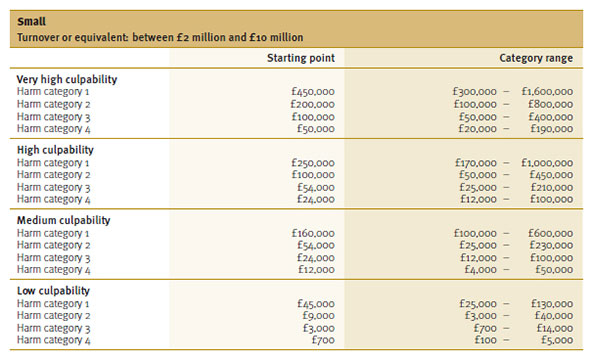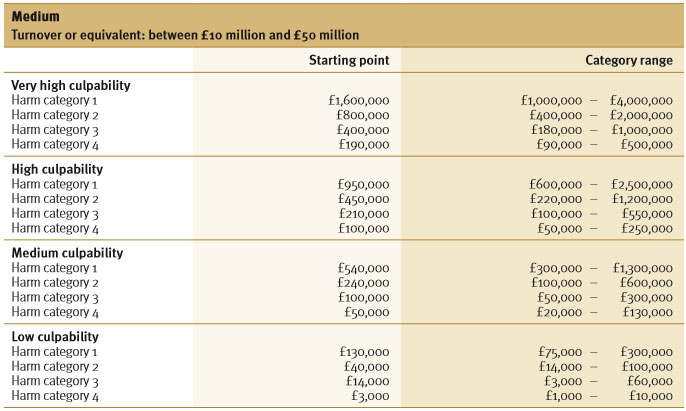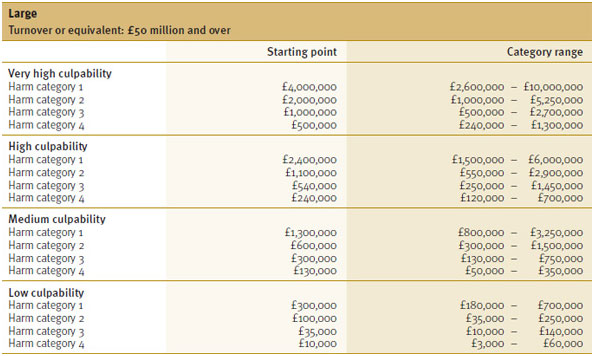The most dramatic change in health and safety enforcement since 1974

The new sentencing guidelines for health and safety offences are set to revolutionise punishment for health and safety offences that are committed.
The Sentencing Council’s have increased the level of fines for serious offences, particularly for larger companies; whilst reserving prison sentences for very serious offences. The formulaic approach laid down in the new guidelines will greatly increase fines across the board and most dramatically for very large companies. Many more directors, managers and employees will be handed custodial sentences due to a significantly lower threshold for imprisonment. The new sentencing guidelines apply to health and safety offences committed by organisations and individuals who breech or flout the laws, as well as to corporate manslaughter and food safety/hygiene offences. They introduce a structured nine step approach that the Court has to follow, so as to calculate sentences. This involves plugging culpability and harm factors into a series of tables to reach recommended starting point fines, as well as ranges of fines above and below the starting points. The new regime has been carefully calculated and will certainly improve consistency across England and Wales. It was published in draft for consultation in November 2014 and the final version published were brought into effect on the 1st February 2016 where little has changed from the draft, with the same figures and tables for fines as in the draft. These will apply to sentences handed down from 1 February 2016, which make the guidelines retrospective in the sense that they apply to offences that have already been committed and have not yet come up for sentencing. These new guidelines along with the Fee for Intervention that came into effect in October 2012 for the HSE to recover costs from businesses that an HSE inspector has deemed to be in ‘material breach’ of health and safety legislation. It could be a very costly exercise by not being compliant to the health and safety acts and regulations.
Observations on the new guidelines are as follows:
1. Easy to fall into the ‘very high’ culpability category
The first step of the process is to allocate a culpability factor, ranging from ‘very high’ to ‘low’, which in turn will drive the allocation of a recommended fine. The ‘very high’ category is triggered if there has been a ‘deliberate breach of or flagrant disregard for the law’. Although that sounds very serious, with hindsight it may be all too easy for breaches to fall into this category.
It is not uncommon for employers to identify a safety problem and know they are non-compliant; this becomes a ‘deliberate breach’ if they don’t remedy it. If prosecuted, they may now all too easily find themselves at the sharpest end of the new regime.
2. The shift from outcome based sentencing to risk based sentencing
The main health & safety offences are based on exposing people to risk. However, enforcement practice (as driven by public expectation) looks much more closely at outcome. Breaches causing serious injuries and death have until now been much more likely to be prosecuted than mere exposure to risk; and the sentences have also been much heavier.
The Sentencing Council has adopted a new rationale, dictating that punishment should much more closely fit the level of exposure to risk. So, exposing someone to a high risk of death should warrant almost the same sentence regardless of whether there is a fatality or merely an exposure to risk without any injury.The consequence of this well intentioned change is to escalate offences that were previously dealt with moderately into the higher reaches of the new formulae. Imagine, a loose railing is discovered on a busy walkway that could lead to somebody falling from a height of 10 feet. The high risk of death or disability from someone falling can take this straight into the most serious harm category, even if nobody has fallen.
3. Designating likelihood of harm as ‘low’, ‘medium’ or ‘high’
One of the steps is to designate the likelihood of harm as being ‘high’, ‘medium’ or ‘low’. That appears to be sensible. However, it may give false reassurance as to the fairness and objectivity of the new system. If 100 people walk along the unsafe walkway each day, risking a fall of 10 feet, is there a high, medium or low risk that someone will be killed or disabled?
The problem is that ‘high’, ‘medium’ and ‘low’ are prone to wildly different interpretations. Suppose the experts agree that there was a 1 in 10 risk that someone would have been killed or disabled by falling from that walkway throughout the period of the breach. Even with such a precise expert view, is that a high, medium or low likelihood? The court would struggle to answer that question without understanding the wider circumstances, looking at culpability and what actually happened. But those factors are intended to be excluded from this stage of the calculation to make the process rigorous and fair.
4. Extrapolation of fines for organisations whose turnover very greatly exceeds £50million
This issue will grab headlines in due course. The guidelines, in combination with the Court of Appeal’s July 2015 judgement against Thames Water Utilities, pave the way for the very large companies to be fined in excess of £100million for the most serious offences. That is clearly the Court of Appeal’s intention.
5. Lower threshold for imprisonment
The culpability factor and harm category process is also used in order to produce a guideline starting point punishment for individuals. At the more serious end of the scale, the court is driven to impose a custodial sentence. So, where does the threshold for imprisonment now lie?
My interpretation of the new threshold is as follows: if a director or employee knows there is a breach of the law that has at least a medium likelihood of causing death or disability, then the court is directed as a starting point to impose a punishment of one year’s imprisonment, with a range of between 6 and 18 months depending on other relevant factors. Many will judge this to be fair if there has been a fatal accident. But alarmingly, imprisonment will be the conclusion even if there has been no accident at all – just exposure to risk.
This is a very significant reduction in the threshold for imprisonment for health and safety offences.
In summary, the sentencing guidelines adopt a range of well-intentioned and apparently rational changes. However, the outcome will be very much more dramatic than intended, with much greater fines across the board and more individuals being imprisoned for offences that would not previously have been regarded as sufficiently serious to merit a custodial sentence. It remains to be seen whether these changes will improve prevention and save lives.

In order to assign proportionate fines that have a significant impact on a business’ finances and to deter the company from making the same offence again, the Sentencing Council separates businesses into the four following categories based on turnover and applies fines accordingly:
- Micro organisations: Turnover not more than £2 million
- Small organisations: Turnover between £2 million and £10 million
- Medium organisations: Turnover between £10 million and £50 million
- Large organisations: Turnover of £50 million or more
Very large organisation Where an offending organisation’s turnover or equivalent very greatly exceeds the threshold for large organisations, it may be necessary to move outside the suggested range to achieve a proportionate sentence




Remain Compliant to Avoid FFI Fines and fines from the new changes
October 2015 marked the third anniversary of the HSE’s Fee for Intervention (FFI)scheme. The scheme allows the HSE to recover costs from businesses that an HSE inspector has deemed to be in ‘material breach’ of health and safety legislation. Once a breach has been identified, the business will be charged £124 per hour while an inspector investigates and works to resolve the issue. To date, the HSE has issued 47,830 invoices under the scheme and recovered almost £30 million – with the average fee costing each business £770. Regardless of whether you manage a small shop or a large national manufacturing firm, an HSE inspector may find an aspect of your operation to be in material breach.
While the scheme provides no firm definition for material breach as each HSE inspector is able to form his or her own definition – it does provide several concrete examples:
- Inadequate machine guards
- Outdated or non-existent risk assessments
- Poorly defined travel routes either on a construction site, public road or within a building
- Not providing adequate facilities, such as no hot or cold water, for on-site workers
- Ineffective management procedures
After an invoice has been served, a business has 21 days to either challenge it or pay it. However, by paying the invoice, your business is admitting to the breach of health and safety, and the HSE could cite that as evidence in the future. Therefore, the most beneficial practice that your business can implement is a thorough risk management scheme that is reviewed at least annually and takes employees’ concerns into consideration.
Experience when it is needed.
Since 1995 Brunel Management Services has been supporting businesses throughout the UK with a full range of health and safety consultancy services.

We provide a highly personal approach to our service with:
- A single point of contact, no call centres
- Bespoke Health and Safety policy and documentation
- National coverage of highly qualified Health, Safety and Environmental consultants that are employed by us, not subcontracted
- 24/7 support, no answer phones
Brunel Management Services consultants have a wealth of experience and knowledge of health and safety, and each consultant have qualifications in this field that class them as competent in the eyes of the law. With the new levels of fines and costs that are now in place these could have a crippling effect on any business. Our highly experience consultants are there to help you remain compliant to avoid these fines and cost and implement a fully comprehensive health and safety system that will be fully compliant to any health and safety act or regulation. For these reasons, Brunel Management Services should be your first port of call to ensure we are there to help you and keep you compliment.
Please contact a Health & Safety Consultant with any questions.
HSE Prosecutions
Companies sentenced in HSE inspector’s ‘most horrific case’
Valmet Ltd and Sonae Industrial (UK) Ltd were fined £410,000 and ordered to pay £214,000 in costs after two workers lost their lives at a Merseyside woodchip factory. Both men were performing maintenance on the conveyor when it unexpectedly began to operate—dragging both men into the machinery. In its investigation, the HSE found that both companies failed to conduct risk assessments for the task as well as provide proper safety precautions.
Care provider prosecuted after disabled man died from severe scalding
Ark Housing Association Limited was fined £75,000 after a care worker lowered a patient into a scalding hot bath. The 60-year old man had limited movement as a result of being diagnosed with cerebral palsy and had also been diagnosed with epilepsy. When the care worker lowered the man into the bath without checking the water temperature, the man suffered an epileptic fit, as well as severe burns to his feet and lower legs. The injuries caused the man to die after two weeks spent in hospital. In its investigation, the HSE found that the company had not provided its staff with training or instruction on the proper bath and shower procedures nor did it provide thermometers to its staff.
National Grid fined £2 million over school boy’s death
National Grid, one of the largest gas distributors in the United Kingdom, was fined £2 million and ordered to pay £36,102.90 in costs after a boy was killed playing on one of its pipelines. The 11-year-old boy and his two friends were running along the pipeline to cross the Leeds and Liverpool Canal when the child slipped, struck his head and plunged into the canal- causing him to drown. In its inspection, the HSE found that the company’s records had incorrectly recorded that the pipe was buried and not exposed. This error caused the company to not install safety devices to prevent accidents such as this during regular inspections.
Accident repair company fined for failure to comply
DM Accident Repair Centre Limited, an accident repair company, was fined £20,000 and ordered to pay £4,666 in costs after it failed to comply with an improvement notice from the HSE. The company had been using a spray booth that had not been inspected by a competent person. After issuing the notice, the owner was found to be uncooperative—even after repeated attempts from the HSE to get the business to comply.
